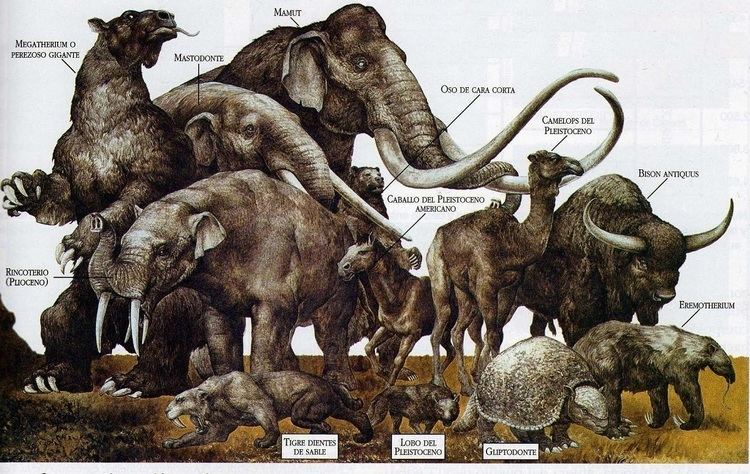 | ||
Mass Giraffe: 1,200 kg, Hippopotamus: 1,500 – 1,800 kg Lifespan Hippopotamus: 40 – 50 years, Asian elephant: 48 years Height Giraffe: 5 – 6 m, Hippopotamus: 1.5 m Speed Giraffe: 60 km/h, Hippopotamus: 30 km/h, Muskox: 60 km/h Length Giraffe: 4.2 m, Hippopotamus: 3.3 – 5.2 m Gestation period Giraffe: 13 – 15 months Representative species Woolly mammoth, Diprotodon, Woolly rhinoceros, Hippopotamus, American bison | ||
In terrestrial zoology, megafauna (Ancient Greek mégalo "large" + New Latin fauna "animal") are large or giant animals. The most common thresholds used are weight over 40 kilograms (90 lb), over 44 kilograms (100 lb), or over a metric ton 1,000 kilograms (2,205 lb). This includes many species not popularly thought of as overly large, such as white-tailed deer, red kangaroo, and humans.
Contents
- Ecological strategy
- Evolution of large body size
- In terrestrial mammals
- In marine mammals
- In flightless birds
- In giant turtles
- Timing and possible causes
- Effect on nutrient transport
- Effect on methane emissions
- Examples
- References

In practice, the most common usage encountered in academic and popular writing describes land mammals roughly larger than a human that are not (solely) domesticated. The term is especially associated with the Pleistocene megafauna – the land animals often larger than modern counterparts considered archetypical of the last ice age, such as mammoths, the majority of which in northern Eurasia, the Americas and Australia became extinct as recently as 10,000–40,000 years ago. It is also commonly used for the largest extant wild land animals, especially elephants, giraffes, hippopotamuses, rhinoceroses, and large bovines. Megafauna may be subcategorized by their trophic position into megaherbivores (e.g., elk), megacarnivores (e.g., lions), and, more rarely, megaomnivores (e.g., bears).
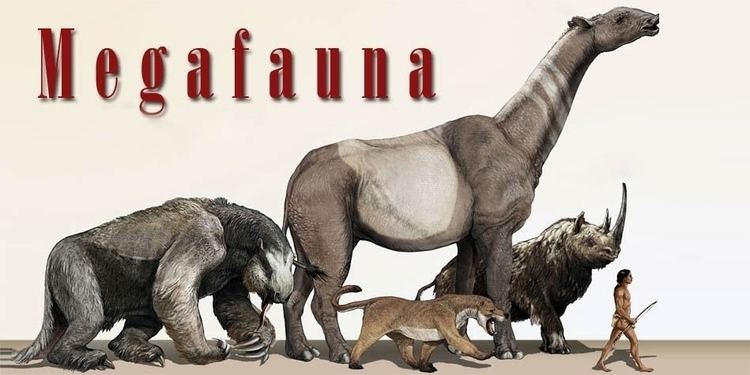
Other common uses are for giant aquatic species, especially whales, any larger wild or domesticated land animals such as larger antelope and cattle, as well as numerous dinosaurs and other extinct giant reptilians.
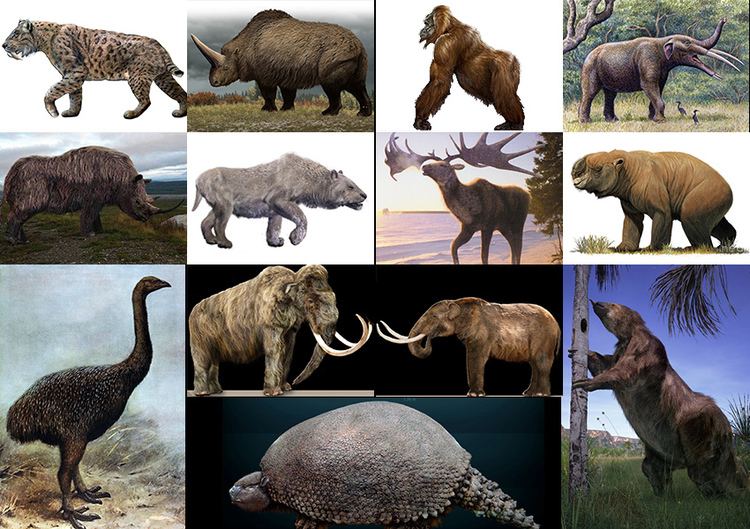
The term is also sometimes applied to animals (usually extinct) of great size relative to a more common or surviving type of the animal, for example the 1 m (3 ft) dragonflies of the Carboniferous period.
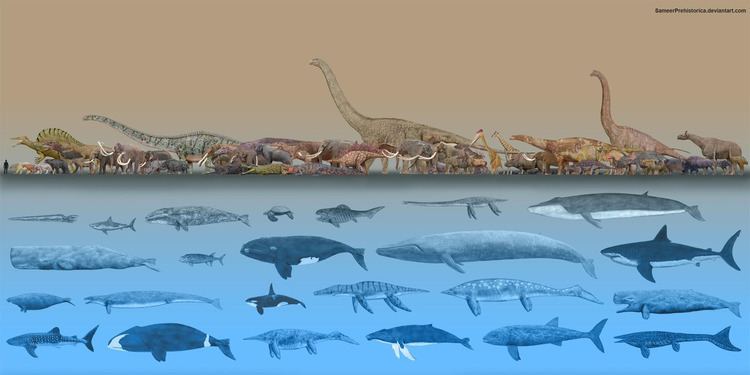
Ecological strategy
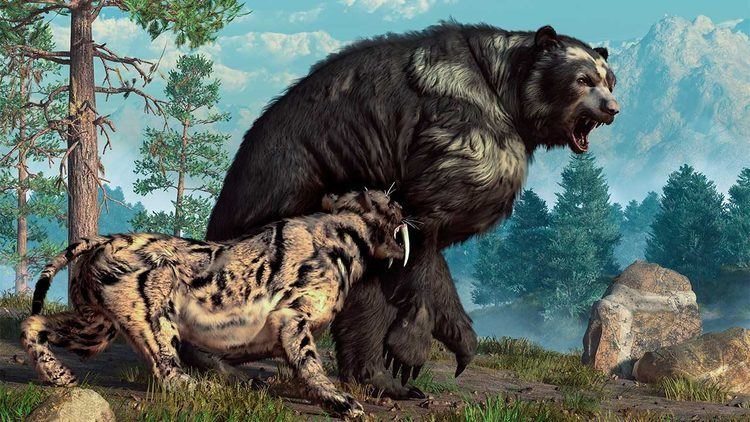
Megafauna – in the sense of the largest mammals and birds – are generally K-strategists, with high longevity, slow population growth rates, low mortality rates, and (at least for the largest) few or no natural predators capable of killing adults. These characteristics, although not exclusive to such megafauna, make them vulnerable to human overexploitation, in part because of their slow population recovery rates.
Evolution of large body size
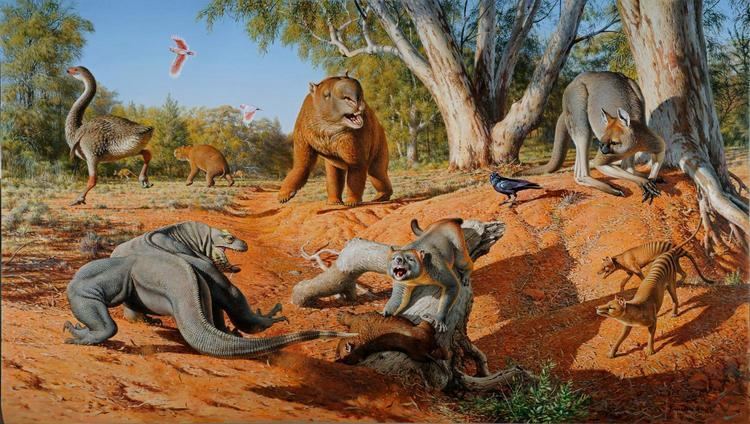
One observation that has been made about the evolution of larger body size is that rapid rates of increase that are often seen over relatively short time intervals are not sustainable over much longer time periods. In an examination of mammal body mass changes over time, the maximum increase possible in a given time interval was found to scale with the interval length raised to the 0.25 power. This is thought to reflect the emergence, during a trend of increasing maximum body size, of a series of anatomical, physiological, environmental, genetic and other constraints that must be overcome by evolutionary innovations before further size increases are possible. A strikingly faster rate of change was found for large decreases in body mass, such as may be associated with the phenomenon of insular dwarfism. When normalized to generation length, the maximum rate of body mass decrease was found to be over 30 times greater than the maximum rate of body mass increase for a ten-fold change.
In terrestrial mammals
Subsequent to the Cretaceous–Paleogene extinction event that eliminated the non-avian dinosaurs about 66 Ma ago, terrestrial mammals underwent a nearly exponential increase in body size as they diversified to occupy the ecological niches left vacant. Starting from just a few kg before the event, maximum size had reached ~50 kg a few million years later, and ~750 kg by the end of the Paleocene. This trend of increasing body mass appears to level off about 40 Ma ago (in the late Eocene), suggesting that physiological or ecological constraints had been reached, after an increase in body mass of over three orders of magnitude. However, when considered from the standpoint of rate of size increase per generation, the exponential increase is found to have continued until the appearance of Indricotherium 30 Ma ago. (Since generation time scales with body mass0.259, increasing generation times with increasing size cause the log mass vs. time plot to curve downward from a linear fit.)
Megaherbivores eventually attained a body mass of over 10 000 kg. The largest of these, indricotheres and proboscids, have been hindgut fermenters, which are believed to have an advantage over foregut fermenters in terms of being able to accelerate gastrointestinal transit in order to accommodate very large food intakes. A similar trend emerges when rates of increase of maximum body mass per generation for different mammalian clades are compared (using rates averaged over macroevolutionary time scales). Among terrestrial mammals, the fastest rates of increase of body mass0.259 vs. time (in Ma) occurred in perissodactyls (a slope of 2.1), followed by rodents (1.2) and proboscids (1.1), all of which are hindgut fermenters. The rate of increase for artiodactyls (0.74) was about a third that of perissodactyls. The rate for carnivorans (0.65) was slightly lower yet, while primates, perhaps constrained by their arboreal habits, had the lowest rate (0.39) among the mammalian groups studied.
Terrestrial mammalian carnivores from several eutherian groups (the mesonychid Andrewsarchus, the creodonts Megistotherium and Sarkastodon, and the carnivorans Amphicyon and Arctodus) all reached a maximum size of about 1000 kg (the carnivoran Arctotherium apparently actually got somewhat larger). The largest known metatherian carnivore, Proborhyaena gigantea, apparently reached 600 kg, also close to this limit. A similar theoretical maximum size for mammalian carnivores has been predicted based on the metabolic rate of mammals, the energetic cost of obtaining prey, and the maximum estimated rate coefficient of prey intake. It has also been suggested that maximum size for mammalian carnivores is constrained by the stress the humerus can withstand at top running speed.
Analysis of the variation of maximum body size over the last 40 Ma suggests that decreasing temperature and increasing continental land area are associated with increasing maximum body size. The former correlation would be consistent with Bergmann's rule, and might be related to the thermoregulatory advantage of large body mass in cool climates, better ability of larger organisms to cope with seasonality in food supply, or other factors; the latter correlation could be explainable in terms of range and resource limitations. However, the two parameters are interrelated (due to sea level drops accompanying increased glaciation), making the driver of the trends in maximum size more difficult to identify.
In marine mammals
Since tetrapods (first reptiles, later mammals) returned to the sea in the Late Permian, they have dominated the top end of the marine body size range, due to the more efficient intake of oxygen possible using lungs. The ancestors of cetaceans are believed to have been the semiaquatic pakicetids, no larger than wolves, of about 53 million years (Ma) ago. By 40 Ma ago, cetaceans had attained a length of 20 m or more in Basilosaurus, an elongated, serpentine whale that differed from modern whales in many respects and was not ancestral to them. Following this, the evolution of large body size in cetaceans appears to have come to a temporary halt, and then to have backtracked, although the available fossil records are limited. However, in the period from 31 Ma ago (in the Oligocene) to the present, cetaceans underwent a significantly more rapid sustained increase in body mass (a rate of increase in body mass0.259 of a factor of 3.2 per million years) than achieved by any group of terrestrial mammals. This trend led to the largest animal of all time, the modern blue whale. Several reasons for the more rapid evolution of large body size in cetaceans are possible. Fewer biomechanical constraints on increases in body size may be associated with suspension in water as opposed to standing against the force of gravity, and with swimming movements as opposed to terrestrial locomotion. Also, the greater heat capacity and thermal conductivity of water compared to air may increase the thermoregulatory advantage of large body size in marine endotherms, although diminishing returns apply.
Cetaceans are not the only marine mammals to reach unprecedented size in the modern era. The largest carnivoran of all time is the mostly aquatic modern southern elephant seal.
In flightless birds
Because of the small initial size of all mammals following the extinction of the dinosaurs, nonmammalian vertebrates had a roughly ten-million-year-long window of opportunity (during the Paleocene) for evolution of gigantism without much competition. During this interval, apex predator niches were often occupied by reptiles, such as terrestrial crocodilians (e.g. Pristichampsus), large snakes (e.g. Titanoboa) or varanid lizards, or by flightless birds (e.g. Paleopsilopterus in South America). This is also the period when megafaunal flightless herbivorous gastornithid birds evolved in the Northern Hemisphere, while flightless paleognaths evolved to large size on Gondwanan land masses and Europe. Gastornithids and at least one lineage of flightless paleognath birds originated in Europe, both lineages dominating niches for large herbivores while mammals remained below 45 kg (in contrast with other landmasses like North America and Asia, which saw the earlier evolution of larger mammals) and were the largest European tetrapods in the Paleocene.
Flightless paleognaths, termed ratites, have traditionally been viewed as representing a lineage separate from that of their small flighted relatives, the Neotropic tinamous. However, recent genetic studies have found that tinamous nest well within the ratite tree, and are the sister group of the extinct moa of New Zealand. Similarly, the small kiwi of New Zealand have been found to be the sister group of the extinct elephant birds of Madagascar. These findings indicate that flightlessness and gigantism arose independently multiple times among ratites via parallel evolution.
Predatory megafaunal flightless birds were often able to compete with mammals in the early Cenozoic. Later in the Cenozoic, however, they were displaced by advanced carnivorans and died out. In North America, the bathornithids Paracrax and Bathornis were apex predators but became extinct by the Early Miocene. In South America, the related phorusrhacids shared the dominant predatory niches with metatherian sparassodonts during most of the Cenozoic but declined and ultimately went extinct after eutherian predators arrived from North America (as part of the Great American Interchange) during the Pliocene. In contrast, large herbivorous flightless ratites have survived to the present.
However, none of the largest predatory (Brontornis), possibly omnivorous (Dromornis) or herbivorous (Aepyornis) flightless birds of the Cenozoic ever grew to masses much above 500 kg, and thus never attained the size of the largest mammalian carnivores, let alone that of the largest mammalian herbivores. It has been suggested that the increasing thickness of avian eggshells in proportion to egg mass with increasing egg size places an upper limit on the size of birds. The largest species of Dromornis, D. stirtoni, may have gone extinct after it attained the maximum avian body mass and was then outcompeted by marsupial diprotodonts that evolved to sizes several times larger.
In giant turtles
Giant tortoises were very important components of late Cenozoic faunas, occurring in virtually every continent until the arrival of homininans. The largest known terrestrial tortoise was Megalochelys atlas, an animal that probably weighed about 1000 kg.
Some earlier aquatic Testudines, e.g. the marine Archelon of the Cretaceous and freshwater Stupendemys of the Miocene, were considerably larger, weighing more than 2000 kg.
Timing and possible causes
The Holocene extinction (see also Quaternary extinction event), occurred at the end of the last ice age glacial period (a.k.a. the Würm glaciation) when many giant ice age mammals, such as woolly mammoths, went extinct in the Americas and northern Eurasia. An analysis of the extinction event in North America found it to be unique among Cenozoic extinction pulses in its selectivity for large animals. Various theories have attributed the wave of extinctions to human hunting, climate change, disease, a putative extraterrestrial impact, or other causes. However, this extinction near the end of the Pleistocene was just one of a series of megafaunal extinction pulses that have occurred during the last 50,000 years over much of the Earth's surface, with Africa and southern Asia (where the local megafauna had a chance to evolve alongside modern humans) being comparatively less affected. The latter areas did suffer a gradual attrition of megafauna, particularly of the slower-moving species (a class of vulnerable megafauna epitomized by giant tortoises), over the last several million years.
Outside the mainland of Afro-Eurasia, these megafaunal extinctions followed a highly distinctive landmass-by-landmass pattern that closely parallels the spread of humans into previously uninhabited regions of the world, and which shows no overall correlation with climatic history (which can be visualized with plots over recent geological time periods of climate markers such as marine oxygen isotopes or atmospheric carbon dioxide levels). Australia and nearby islands (e.g., Flores) were struck first around 46,000 years ago, followed by Tasmania about 41,000 years ago (after formation of a land bridge to Australia about 43,000 years ago), Japan apparently about 30,000 years ago, North America 13,000 years ago, South America about 500 years later, Cyprus 10,000 years ago, the Antilles 6,000 years ago, New Caledonia and nearby islands 3,000 years ago, Madagascar 2,000 years ago, New Zealand 700 years ago, the Mascarenes 400 years ago, and the Commander Islands 250 years ago. Nearly all of the world's isolated islands could furnish similar examples of extinctions occurring shortly after the arrival of humans, though most of these islands, such as the Hawaiian Islands, never had terrestrial megafauna, so their extinct fauna were smaller.
An analysis of the timing of Holarctic megafaunal extinctions and extirpations over the last 56,000 years has revealed a tendency for such events to cluster within interstadials, periods of abrupt warming, but only when humans were also present. Humans may have impeded processes of migration and recolonization that would otherwise have allowed the megafaunal species to adapt to the climate shift. In at least some areas, interstadials were periods of expanding human populations.
An analysis of Sporormiella fungal spores (which derive mainly from the dung of megaherbivores) in swamp sediment cores spanning the last 130,000 years from Lynch's Crater in Queensland, Australia, showed that the megafauna of that region virtually disappeared about 41,000 years ago, at a time when climate changes were minimal; the change was accompanied by an increase in charcoal, and was followed by a transition from rainforest to fire-tolerant sclerophyll vegetation. The high-resolution chronology of the changes supports the hypothesis that human hunting alone eliminated the megafauna, and that the subsequent change in flora was most likely a consequence of the elimination of browsers and an increase in fire. The increase in fire lagged the disappearance of megafauna by about a century, and most likely resulted from accumulation of fuel once browsing stopped. Over the next several centuries grass increased; sclerophyll vegetation increased with a lag of another century, and a sclerophyll forest developed after about another thousand years. During two periods of climate change about 120,000 and 75,000 years ago, sclerophyll vegetation had also increased at the site in response to a shift to cooler, drier conditions; neither of these episodes had a significant impact on megafaunal abundance. Similar conclusions regarding the culpability of human hunters in the disappearance of Pleistocene megafauna were derived from high-resolution chronologies obtained via an analysis of a large collection of eggshell fragments of the flightless Australian bird Genyornis newtoni, from analysis of Sporormiella fungal spores from a lake in eastern North America and from study of deposits of Shasta ground sloth dung left in over half a dozen caves in the American southwest.
Continuing human hunting and environmental disturbance has led to additional megafaunal extinctions in the recent past, and has created a serious danger of further extinctions in the near future (see examples below).
A number of other mass extinctions occurred earlier in Earth's geologic history, in which some or all of the megafauna of the time also died out. Famously, in the Cretaceous–Paleogene extinction event the dinosaurs and most other giant reptilians were eliminated. However, the earlier mass extinctions were more global and not so selective for megafauna; i.e., many species of other types, including plants, marine invertebrates and plankton, went extinct as well. Thus, the earlier events must have been caused by more generalized types of disturbances to the biosphere.
Effect on nutrient transport
Megafauna play a significant role in the lateral transport of mineral nutrients in an ecosystem, tending to translocate them from areas of high to those of lower abundance. They do so by their movement between the time they consume the nutrient and the time they release it through elimination (or, to a much lesser extent, through decomposition after death). In South America's Amazon Basin, it is estimated that such lateral diffusion was reduced over 98% following the megafaunal extinctions that occurred roughly 12,500 years ago. Given that phosphorus availability is thought to limit productivity in much of the region, the decrease in its transport from the western part of the basin and from floodplains (both of which derive their supply from the uplift of the Andes) to other areas is thought to have significantly impacted the region's ecology, and the effects may not yet have reached their limits.
Effect on methane emissions
Large populations of megaherbivores have the potential to contribute greatly to the atmospheric concentration of methane, which is an important greenhouse gas. Modern ruminant herbivores produce methane as a byproduct of foregut fermentation in digestion, and release it through belching or flatulence. Today, around 20% of annual methane emissions come from livestock methane release. In the Mesozoic, it has been estimated that sauropods could have emitted 520 million tons of methane to the atmosphere annually, contributing to the warmer climate of the time (up to 10 °C warmer than at present). This large emission follows from the enormous estimated biomass of sauropods, and because methane production of individual herbivores is believed to be almost proportional to their mass.
Recent studies have indicated that the extinction of megafaunal herbivores may have caused a reduction in atmospheric methane. This hypothesis is relatively new. One study examined the methane emissions from the bison that occupied the Great Plains of North America before contact with European settlers. The study estimated that the removal of the bison caused a decrease of as much as 2.2 million tons per year. Another study examined the change in the methane concentration in the atmosphere at the end of the Pleistocene epoch after the extinction of megafauna in the Americas. After early humans migrated to the Americas about 13,000 BP, their hunting and other associated ecological impacts led to the extinction of many megafaunal species there. Calculations suggest that this extinction decreased methane production by about 9.6 million tons per year. This suggests that the absence of megafaunal methane emissions may have contributed to the abrupt climatic cooling at the onset of the Younger Dryas. The decrease in atmospheric methane that occurred at that time, as recorded in ice cores, was 2-4 times more rapid than any other decrease in the last half million years, suggesting that an unusual mechanism was at work.
Examples
The following are some notable examples of animals often considered as megafauna (in the sense of the "large animal" definition). This list is not intended to be exhaustive:
